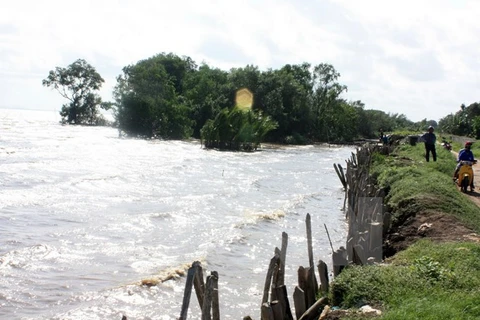Ca Mau (VNA) – The southernmost province of Ca Mau has struggled to effectively resettle residents affected by soil erosion in coastal areas.
The erosion occurs on the province’s western and eastern shorelines at a rate of 20-25 metres each year on average and up to 50 metres in some places.
According to statistics from Ca Mau province’s Department of Agriculture and Rural Development, since 2007 up to 80 percent of Ca Mau’s coastline suffered from erosion and 304 hectares of protection forest were lost each year.
To Quoc Nam, Deputy Director of the department said a total of more than 40.6 kilometres of eroded shoreline was at dangerous levels, including 23 kilometres at the extremely dangerous level, thus threatening the sea dyke system and residential areas.
In 2015, up to 5,100 metres in Khanh Tien commune in U Minh district and the 900m section from Vam Da Bac to Vam Kenh Moi in Khanh Binh Tay commune in Tran Van Thoi district suffered extremely serious erosion.
“Eroded areas are threatening the safety of the western sea dyke system as well as lives of locals within the dyke,” Nguyen Long Hoai, head of Ca Mau’s Irrigation Division, said.
The department said 26,000 households still need to be relocated from landslide-prone areas.
The province has considered building resettlement areas but the plans face various problems.
To Quoc Nam said to adapt to climate change, Ca Mau began building resettlement areas along the western shoreline for locals illegally living close to the river, sea and dyke buffer corridor.
But no resettlement areas have been completed due to lack of capital.
He said Ca Mau needs an additional 84 billion VND (3.7 million USD) to complete infrastructure in resettlement areas such as roads, drainage systems, lighting systems and schools.
He said the government’s assistance is vital to completing the projects.-VNA

Measures to reduce land erosion in Dak Lak province
The Central Highlands province of Dak Lak needs a proper land use strategy to mitigate soil erosion and develop existing land resources, scientists have recommended.























